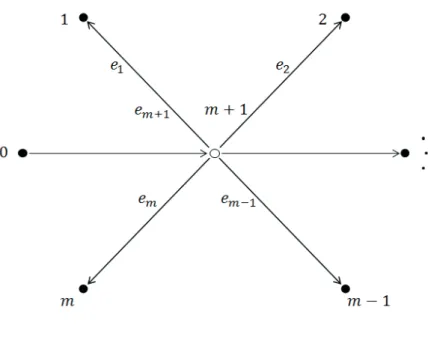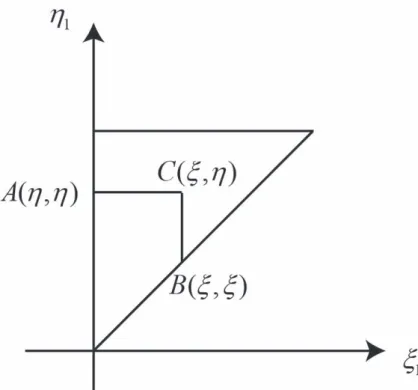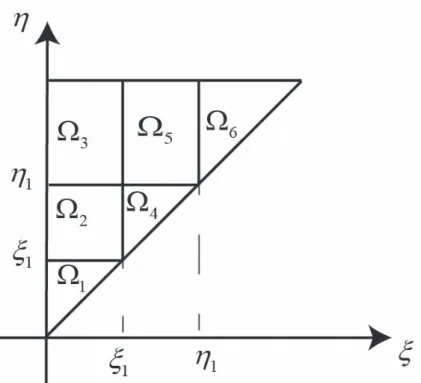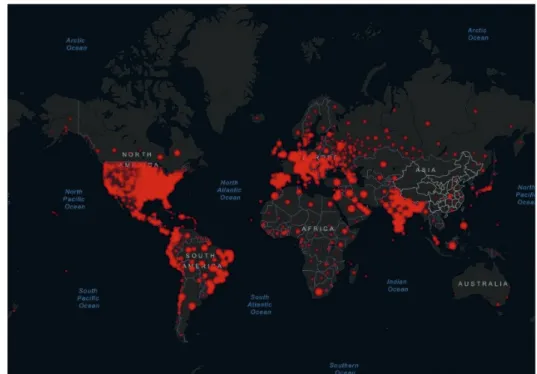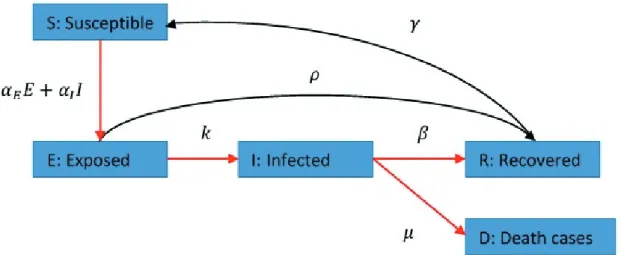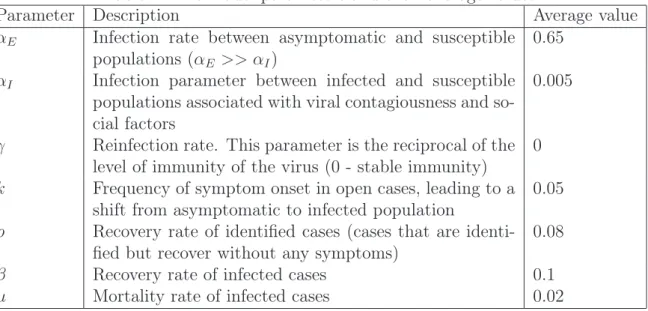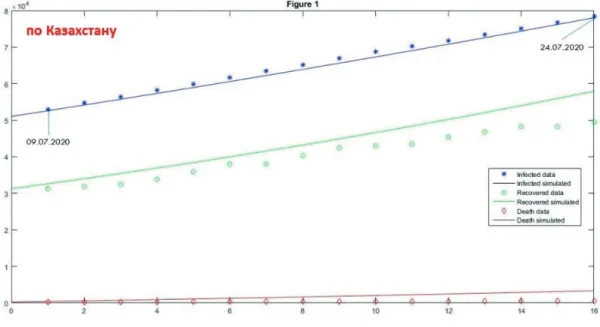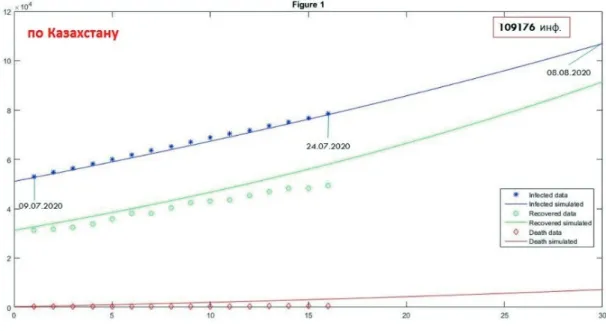ISSN 1563−0277 eISSN 2617−4871
ӘЛ-ФАРАБИ атындағы ҚАЗАҚ ҰЛТТЫҚ УНИВЕРСИТЕТI
ХАБАРШЫ
Математика, механика, информатика сериясы
КАЗАХСКИЙ НАЦИОНАЛЬНЫЙ УНИВЕРСИТЕТ имени АЛЬ-ФАРАБИ
ВЕСТНИК
Серия математика, механика, информатика
AL-FARABI KAZAKH NATIONAL UNIVERSITY
Journal of Mathematics, Mechanics and Computer Science
№3 (111)
Алматы
«Қазақ университетi»
2021
Зарегистрирован в Министерстве информации и коммуникаций Республики Казахстан, свидетельство №16508-Ж от 04.05.2017 г. (Времяи номер первичной постановки на учет
№766 от 22.04.1992 г.). Язык издания: казахский, русский, английский. Выходит 4 раза в год.
Тематическаянаправленность: теоретическаяи прикладнаяматематика, механика, информатика.
Редакционная коллегия
научный редактор– Б.Е. Кангужин, д.ф.-м.н., профессор, КазНУ им. аль-Фараби,
заместитель научного редактора–Д.И. Борисов, д.ф.-м.н., профессор, Институт математики с вычислительным центром Уфимского научного центра РАН, Башкирский государственный педагогический
университет им. М. Акмуллы, Россия
ответственный секретарь–С.Е. Айтжанов, к.ф.-м.н., доцент, КазНУ им. аль-Фараби Айсагалиев С.А. – д.т.н., профессор, КазНУ им.аль-Фараби, Казахстан
Ахмед-Заки Д.Ж. – д.т.н., Astana IT University, Казахстан
Бадаев С.А. – д.ф.-м.н., профессор, Казахстанско-Британский технический университет, Казахстан Бектемесов М.А. – д.ф.-м.н., профессор, Казахский национальный педагогический
университет имени Абая, Казахстан
Жакебаев Д.Б. – PhD доктор, КазНУ им.аль-Фараби, Казахстан
Кабанихин С.И. – д.ф.-м.н., профессор, чл.-корр. РАН, Институт вычислительной математики и математической геофизики СО РАН, Россия
Майнке М. – профессор, Департамент Вычислительной гидродинамики Института аэродинамики, Германия
Малышкин В.Э. – д.т.н., профессор, Новосибирский государственный технический университет, Россия
Ракишева З.Б. – к.ф.-м.н., доцент, КазНУ им.аль-Фараби, Казахстан
Ружанский М. – д.ф.-м.н., профессор, Имперский колледж Лондона, Великобритания Сагитов С.М. – д.ф.-м.н., профессор, Университет Гетеборга, Швеция
Сукочев Ф.А. – профессор, академик АН Австралии, Университет Нового Южного Уэльса, Австралия Тайманов И.А. – д.ф.-м.н., профессор, академик РАН, Институт математики
им. С.Л. Соболева СО РАН, Россия
Темляков В.Н. – д.ф.-м.н., профессор, Университет Южной Каролины, США Токмагамбетов Н.Е. – PhD доктор, КазНУ им.аль-Фараби, Казахстан Шиничи Накасука – PhD доктор, профессор, Университет Токио, Япония
Индексируется
Научное издание
Вестник КазНУ. Серия “Математика, механика, информатика”, № 3 (111) 2021.
Редактор – С.Е. Айтжанов. Компьютерная верстка – С.Е. Айтжанов ИБ N 14954
Формат60×84 1/8. Бумага офсетная. Печать цифровая. Объем 8,8 п.л.
Заказ N 9038. Издательский дом “Қазақ университетi”
Казахского национального университета им. аль-Фараби. 050040, г. Алматы, пр.аль-Фараби, 71, КазНУ.
Отпечатано в типографии издательского дома “Қазақ университетi”.
c КазНУ им. аль-Фараби, 2021
ISSN 1563–0277, eISSN 2617-4871 JMMCS. №3(111). 2021 https://bm.kaznu.kz
1-бөлiм Раздел 1 Section 1
Математика Математика Mathematics
IRSTI 27.31.15 DOI: https://doi.org/10.26577/JMMCS.2021.v111.i3.01
A.M. Ayazbayeva2 , K.B. Imanberdiyev1,2∗ , A.S. Kassymbekova1,2
1Al-Farabi Kazakh National University, Kazakhstan, Almaty
2Institute of Mathematics and Mathematical Modeling, Kazakhstan, Almaty
∗e-mail: [email protected]
ON STABILIZATION PROBLEM FOR A LOADED HEAT EQUATION:
THE TWO-DIMENSIONAL CASE
One of the important properties that characterize the behavior of solutions of boundary value problems for differential equations is stabilization, which has a direct relationship with the problems of controllability. The problems of solvability of stabilization problems of two- dimensional loaded equations of parabolic type with the help of feedback control given on the boundary of the region are investigated in the article. These equations have numerous applications in the study of inverse problems for differential equations. The problem consists in the choice of boundary conditions (controls), so that the solution of the boundary value problem tends to a given stationary solution at a certain speed at t → ∞. This requires that the control is feedback, i.e. that it responds to unintended fluctuations in the system, suppressing the results of their impact on the stabilized solution. The spectral properties of the loaded two-dimensional Laplace operator, which are used to solve the initial stabilization problem, are also studied. The paper presents an algorithm for solving the stabilization problem, which consists of constructively implemented stages. The idea of reducing the stabilization problem for a parabolic equation by means of boundary controls to the solution of an auxiliary boundary value problem in the extended domain of independent variables belongs to A.V. Fursikov. At the same time, recently, the so-called loaded differential equations are actively used in problems of mathematical modeling and control of nonlocal dynamical systems.
Key words: boundary stabilization, heat equation, spectrum, eigenfunction, loaded Laplace operator.
Ә.М. Аязбаева1, Қ.Б. Иманбердиев1,2∗, А.С. Қасымбекова1,2
1Әл-Фараби атындағы Қазақ ұлттық университетi, Қазақстан, Алматы қ.
2Математика және математикалық модельдеу институты, Қазақстан, Алматы қ.
∗e-mail: [email protected]
Жүктелген жылуөткiзгiштiк теңдеуi үшiн стабилизациялау есебi: екi өлшемдi жағдай Дифференциалдық теңдеулер үшiн шекаралық есептер шешiмдерiнiң табиғатын сипаттай- тын маңызды қасиеттердiң бiрi – стабилизация, бұл басқарылатын есептермен тiкелей бай- ланысты. Мақалада екi өлшемдi жүктелген параболалық теңдеулер үшiн стабилизация есеп- терiнiң шешiмдiлiгi мәселесi облыс шекарасында орнатылған керi байланысты басқаруды қолдана отырып зерттелген. Бұл теңдеулердiң дифференциалдық теңдеулерге арналған керi есептердi зерттеуде көптеген қосымшалары бар. Шектiк есептердi белгiлi жылдамдықпен шешу берiлген стационар шешiмге t → ∞ кезiнде жуықтайтындай етiп, шекаралық шар- ттарды (басқаруларды) таңдау болып табылады. Бұл басқарудың керi байланысты болуын, яғни жүйенiң күтпеген өзгерiстерiне жауап беруi мен олардың стабилизацияланған шешiмге әсерiнiң нәтижелерiн болдырмауын талап етедi. Жүктелген екi өлшемдi Лаплас операторы- ның спектрлiк қасиеттерi де зерттелген, олар бастапқы стабилизация мәселесiн шешу үшiн қолданылады. Мақалада конструктивтi түрде iске асырылған кезеңдерден тұратын стабили- зация есебiн шешудiң алгоритмi келтiрiлген.
c 2021 Al-Farabi Kazakh National University
4 On stabilization problem for a loaded . . .
Параболалық теңдеу үшiн стабилизация есебiн тәуелсiз айнымалылардың кеңейтiлген облысында көмекшi шекаралық есептi шешуге шекаралық басқаруды қолдану арқылы шешу идеясы А.В. Фурсиковке тиесiлi. Сонымен қатар, кейiнгi кездерде жүктелген дифференци- алдық теңдеулер математикалық модельдеу және локальды емес динамикалық жүйелердi басқару есептерiнде белсендi қолданылады.
Түйiн сөздер: шекаралық стабилизация, жылуөткiзгiштiк теңдеуi, спектр, меншiктi функ- циялар, жүктелген Лаплас операторы.
А.М. Аязбаева1, К.Б. Иманбердиев1,2∗, А.С. Касымбекова1,2
1Казахский национальный университет имени аль-Фараби, Казахстан, г. Алматы
2Институт математики и математического моделирования, Казахстан, г. Алматы
∗e-mail: [email protected]
Задача стабилизации для нагруженного уравнения теплопроводности: двумерный случай
Одним из важных свойств, характеризующих поведение решений краевых задач для дифференциальных уравнений, является стабилизация, имеющая прямое отношение к задачам управляемости. В статье исследуются вопросы разрешимости задач стабилизации двумерных нагруженных уравнений параболического типа с помощью управления с обратной связью, заданного на границе области. Эти уравнения имеют многочисленные приложения при исследовании обратных задач для дифференциальных уравнений. Задача состоит в выборе граничных условий (управлений) так, чтобы решение краевой задачи с определенной скоростью приближалось к заданному стационарному решению при t → ∞.
Для этого требуется, чтобы управление было обратной связью, то есть чтобы оно реаги- ровало на непредвиденные возмущения в системе, подавляя результаты их воздействия на стабилизированное решение. Также исследуются спектральные свойства нагруженного двумерного оператора Лапласа, которые используются для решения начальной задачи стабилизации. В статье представлен алгоритм решения задачи стабилизации, состоящий из конструктивно реализованных этапов. Идея сведения задачи стабилизации параболического уравнения с помощью граничных управлений к решению вспомогательной краевой задачи в расширенной области независимых переменных принадлежит А.В. Фурсикову. Кроме того, в последнее время так называемые нагруженные дифференциальные уравнения активно используются в задачах математического моделирования и управления нелокальными динамическими системами.
Ключевые слова: граничная стабилизация, уравнение теплопроводности, спектр, собствен- ные функций, нагруженный оператор Лапласа.
1 Introduction
The idea of reducing the stabilization problem for a parabolic equation by means of boundary controls to the solution of an auxiliary boundary value problem in the extended domain of independent variables belongs to A.V. Fursikov [1]. In [1] the stabilization problem from the boundary∂Ωfor a parabolic equation given in a bounded domainΩ⊂Rn, consists in choosing a boundary condition (a control) such that the solution of the resulting mixed boundary value problem tends ast→ ∞to a given steady-state solution at a prescribed rateexp(−σt). It was proposed in his work [1] and developed further in the works [2–4]. Note that in the works [1–4]
stabilization problems for differential equations without load were considered, i.e. there was no phenomenon of nonlocality. Last thing complicates the implementation of the idea proposed by A.V. Fursikov, especially in parts of constructing eigenfunctions and associated functions for loaded differential operators. At the same time, recently, the so-called loaded differential equations [5–10] are actively used in problems of mathematical modelling and control of
A.M. Ayazbayeva, et al. 5
nonlocal dynamical systems. We have previously studied stabilization problems for a loaded one-dimensional heat equation [11], [12]. In this paper, we investigate stabilization problems for the loaded two-dimensional thermal conductivity equation.
Our work consists of eight sections. Section 1 is an introduction. Section 2 discusses the statement on the problem. In Section 3, an auxiliary boundary value problem is introduced.
In Section 4, the spectral problem for the loaded two-dimensional Laplace operator is investigated. In Section 5 gives main results. In Sections 6 and 7, a biorthogonal system of functions is constructed on the base of eigenfunctions and associated functions. In Section 8, the algorithm for solving the above stabilization problem is described. Finally, Section 9 gives conclusions and discusses possible applications of the results.
2 Statement of the problem
Let Ω = {x, y : −π/2 < x, y < π/2} be a domain with a boundary ∂Ω. In the cylinder Q = Ω× {t > 0} with lateral surface Σ = ∂Ω× {t > 0} we consider the boundary value problem for the loaded heat equation
ut−Δu+αu(0, y, t) +βu(x,0, t) = 0, {x, y, t} ∈Q, (1)
u(x, y,0) =u0(x, y), {x, y} ∈Ω, (2)
u(x, y, t) =p(x, y, t), {x, y, t} ∈Σ, (3)
where α, β ∈C are given (in general case are complex) bounded constants, u0(x, y) is given function. The aim is to find a function p(x, y, t) such that a solution of the boundary value problem (1)–(3) satisfies the inequality
u(x, y, t)L2(Ω)≤C0e−σt, σ >0, t >0. (4) Note that here σ is a given constant and C0 is an arbitrary bounded constant.
Remark 1. In section 8 it will be shown that the solution of the stabilization problem (1)–(4) significantly depends on the values of the coefficients α and β, including the sign of their real parts.
Equation (1) is called a loaded equation [5,6]. We note that problem (1)–(4) with a single load point was studied in [12].
3 Auxiliary boundary value problem (BVP) Let Ω1 ={x, y :−π < x, y < π}and Q1 = Ω1× {t >0}.
zt−Δz+αz(0, y, t) +βz(x,0, t) = 0, {x, y, t} ∈Q1, (5)
z(x, y,0) =z0(x, y), {x, y} ∈Ω1, (6)
∂jz(−π, y, t)
∂xj = ∂jz(π, y, t)
∂xj , {y, t} ∈(−π, π)× {t >0},
∂jz(x,−π, t)
∂yj = ∂jz(x, π, t)
∂yj , {x, t} ∈(−π, π)× {t >0}, j = 0,1. (7)
6 On stabilization problem for a loaded . . .
The problem is to find an initial functionz0(x, y)such that a solution of the BVP (5)–(7) satisfies the inequality
z(x, y, t)L2(Ω1) ≤C0e−σt, σ >0, t >0. (8) We recall, as we indicated above, that here σ is a given constant and C0 is an arbitrary bounded constant.
We will define the function z0(x, y) as a continuation of the function u0(x, y), which was given in the original domain Ω. Thus in the auxiliary boundary value problem (5)–(7) it is needed to find the function z0(x, y) on the square Ω1, so that the requirement (8) is satisfied for a solution z(x, y, t) of the problem (5)–(7). In this case the condition (4) holds for restrictionu(x, y, t)of z(x, y, t)too and a required boundary controlp(x, y, t), {x, y} ∈Σ is defined as trace of functionz(x, y, t) for{x, y, t} ∈Σ.
4 Spectral problem for the loaded twodimensional Laplace operator Let us search a solution of the problem (5)–(7) in the form
z(x, y, t) =
k,l∈Z
Zkl(t)ψkl(x, y), (9)
where{ψkl(x, y), k, l∈Z}is a biorthogonal basis of the spaceL2(Ω1)andZ={0,±1,±2, ...}. The following two spectral problems are considered for the construction of the biorthogonal basis {ψkl(x, y), k, l∈Z} in the domainΩ1 ={x, y :−π < x < π,−π < y < π}:
⎧⎪
⎪⎨
⎪⎪
⎩
−Δϕ(x, y) +αϕ(0, y) =λϕ(x, y),
∂jϕ(−π, y)
∂xj = ∂jϕ(π, y)
∂xj , ∂jϕ(x,−π)
∂yj = ∂jϕ(x, π)
∂yj ,
(10)
⎧⎪
⎪⎨
⎪⎪
⎩
−Δϕ(x, y) +αϕ(0, y) +βϕ(x,0) =λϕ(x, y),
∂jϕ(−π, y)
∂xj = ∂jϕ(π, y)
∂xj , ∂jϕ(x,−π)
∂yj = ∂jϕ(x, π)
∂yj ,
(11)
where j = 0,1, Δ is the Laplace operator, α, β ∈ C are given complex numbers, λ ∈ C is a spectral parameter. A one-dimensional analogue of the problems (10) and (11) is studied in [12].
5 Main results
LetZ={0,±1,±2, . . .}.The following propositions are valid [13].
Theorem 1. (a). Let ∀l ∈ Z:α=l2. Then a system of eigenfunctions and eigenvalues of the problem (10) is defined in the form:
ϕkl(x, y) =
eilx+ α
l2−α eiky, λkl =l2+k2, l ∈Z ≡Z\{0};
A.M. Ayazbayeva, et al. 7
ϕk0(x, y) = eiky, λk0 =α+k2 (l = 0), k∈Z
. (12)
(b). Let∃ l0 ∈Z: α=l20. Then a system of eigenfunctions, associated functions (marked with ∼) and eigenvalues of the problem (10) is defined in the form:
ϕkl(x, y) =
eilx+ α
l2−α eiky, λkl=l2+k2, l∈Z1 ≡Z\{±l0};
ϕkl0(x, y) =eiky, ϕ˜±kl
0(x, y) =e±il0x+iky, λkl0 =α+k2 (α =l02), k∈Z
. (13)
Theorem 2. (a). Let ∀ k, l∈Z: β =k2, α=l2. Then a system of eigenfunctions and eigenvalues for the problem (11) is defined in the form:
ϕkl(x, y) =
eilx+ α l2−α
eiky + β
k2−β , λkl=k2+l2, k, l ∈Z; ϕ0l(x, y) = eilx+ α
l2−α, λ0l =β+l2, l ∈Z; ϕk0(x, y) = eiky+ β
k2 −β, λk0 =k2+α, k ∈Z; ϕ00(x, y) = 1, λ00=α+β
. (14) (b). Let ∀ k ∈ Z : β = k2 and ∃ l0 ∈ Z : α = l02. Then a system of eigenfunctions, associated functions (marked with ∼) and eigenvalues for the problem (11) is defined in the form (where Z1 =Z\{±l0}):
ϕkl(x, y) =
eilx+ α l2−α
eiky + β
k2−β , λkl=k2+l2, k∈Z, l∈Z1; ϕkl0(x, y) =eiky + β
k2−β, ϕ˜±kl
0(x, y) = e±il0x
eiky + β k2−β , λkl0 =k2+α, α=l20, k ∈Z; ϕ0l0(x, y) = 1, ϕ˜±0l
0(x, y) =e±il0x, λ0l0 =α+β
. (15) (c). Let ∀ l ∈ Z : α = l2 and ∃ k0 ∈ Z : β = k02. Then a system of eigenfunctions, associated (marked with ∼) functions and eigenvalues for the problem (11) is defined in the form (where Z2 =Z\{±k0}):
ϕkl(x, y) =
eilx+ α l2−α
eiky + β
k2−β , λkl=k2+l2, k∈Z2, l∈Z; ϕk0l(x, y) =eilx+ α
l2−α, ϕ˜±k
0l(x, y) =e±ik0y
eilx+ α l2−α ,
8 On stabilization problem for a loaded . . .
λk0l=β+l2, β =k02, l∈Z; ϕk00(x, y) = 1, ϕ˜k00(x, y) =e±ik0y, λk00 =α+β
. (16) (d). Let ∃ k0, l0 ∈ Z : β = k02, α = l20. Then a system of eigenfunctions, associated functions (marked with ∼) and eigenvalues for the problem (11) is defined in the form:
ϕkl(x, y) =
eilx+ α l2−α
eiky+ β k2−β , λkl=k2+l2, k∈Z2, l ∈Z1; ϕk0l(x, y) =eilx+ α
l2−α,
˜ ϕ±k
0l(x, y) = e±ik0y
eilx+ α
l2−α , λk0l =β+l2, β =k20, l ∈Z1; ϕkl0(x, y) =eiky + β
k2−β, α+k2, k ∈Z2;
ϕk0l0(x, y) = 1, ϕ˜k0l0(x, y) =e±ik0y, λk0l0 =α+β;
˜
ϕkl0(x, y) =e±il0x
eiky + β
k2−β , α+k2, k∈Z2;
˜
ϕk0l0(x, y) = e±il0x, ϕ˜k0l0(x, y) = e±il0x±ik0y, λk0l0 =α+β
. (17)
6 Construction of biorthogonal system of functions for the cases of Theorem 1 Let us find a biorthogonal sequences for (12) (case (a) from Theorem 1) and for (13) (case (b) of Theorem 1) [13].
Theorem 3. (a). Let ∀l ∈ Z : α =l2. Then a biorthogonal sequence for the basis (12) (case (a) of Theorem 1) is
{ψkl(x, y), k, l∈Z}=
ei(lx+ky), − 1 2π
n∈Z
α
n2−α ·ei(nx+ky), l∈Z, k∈Z
, (18) which defines an biorthogonal basis in L2(Ω1).
(b). Let ∃l0 ∈ Z : α = l02. Then a biorthogonal sequence for the basis (13) (case (b) of Theorem 1) is
{ψkl(x), k, l ∈Z}=
⎧⎨
⎩ei(lx+ky), − 1 2π
n∈Z\{±l0}
α
n2−α ·ei(nx+ky), k ∈Z, l ∈Z
⎫⎬
⎭, (19) which defines an biorthogonal basis in L2(Ω1).
Where we applying the Paley-Wieners theorem ( [14], p.206–207).
A.M. Ayazbayeva, et al. 9
7 Construction of biorthogonal systems for the cases of Theorem 2
Let us find a biorthogonal sequences for (14), (15), (16) and (17) (cases (a), (b), (c) and (d) from Theorem 2, respectively) [13].
Theorem 4. (a). Let ∀ k, l∈Z: β =k2, α=l2. Then a biorthogonal sequence for the basis (14) (case (a) from Theorem 2) is
{ψkl(x, y), k, l∈Z}=
ei(lx+ky), − 1 2π
n∈Z
β
n2−β ·ei(ny+lx),
− 1 2π
n∈Z
α
n2−α ·ei(nx+ky), k, l ∈Z, 1
4π2
m,n∈Z
αβ
(n2−α)(m2−β) ·ei(nx+my)
, (20)
which defines a biorthogonal basis in L2(Ω1).
(b). Let ∀ k ∈Z : β = k2 and ∃ l0 ∈ Z : α = l20. Then a biorthogonal sequence for the basis (15) (case (b) from Theorem 2) is
{ψkl(x, y), k, l∈Z}=
ei(lx+ky), − 1 2π
n∈Z
β
n2−β ·ei(ny+lx),
− 1 2π
n∈Z\{±l0}
α
n2−α ·ei(nx+ky), k, l ∈Z, 1
4π2
n∈Z, m∈Z\{±l0}
αβ
(m2−α)(n2−β)·ei(mx+ny)
⎫⎬
⎭, (21) which defines a biorthogonal basis in L2(Ω1).
(c). Let ∀ l ∈ Z : α = l2 and ∃ k0 ∈ Z : β =k20. Then a biorthogonal sequence for the basis (16) (case (c) from Theorem 2) is
{ψkl(x, y), k, l∈Z}=
⎧⎨
⎩ei(lx+ky), − 1 2π
n∈Z\{±k0}
β
n2 −β ·ei(ny+lx),
− 1 2π
n∈Z
α
n2−α ·ei(nx+ky), k, l ∈Z, 1
4π2
n∈Z\{±k0}, m∈Z
αβ
(m2−α)(n2−β)·ei(mx+ny)
⎫⎬
⎭, (22) which defines a biorthogonal basis in L2(Ω1).
10 On stabilization problem for a loaded . . .
(d). Let ∃k0, l0 ∈ Z : β = k02, α = l20. Then a biorthogonal sequence for the basis (17) (case (d) from Theorem 2) is
{ψkl(x, y), k, l ∈Z}=
⎧⎨
⎩ei(lx+ky), − 1 2π
n∈Z\{±k0}
β
n2−β ·ei(ny+lx),
− 1 2π
n∈Z\{±l0}
α
n2 −α ·ei(nx+ky), k, l∈Z, 1
4π2
n∈Z\{±k0}, m∈Z\{±l0}
αβ
(m2−α)(n2−β)·ei(mx+ny)
⎫⎬
⎭, (23) which defines a biorthogonal basis in L2(Ω1).
8 Algorithm for solving stabilization problem
We propose the following algorithm for solving the stabilization problem for the heat equation with a loaded two-dimensional Laplace operator. It consists of the following constructively implemented steps.
Step 1. We define the function z0(x, y) as a continuation of the given function u0(x, y).
Thus in the auxiliary boundary value problem (5)–(7) it is needed to continue the function z0(x, y) on the square Ω1, so that the requirement (8) is satisfied for a solution z(x, y, t) of the problem (5)–(7). In this case the condition (4) holds as well for its restriction u(x, y, t) and a required boundary controlp(x, y, t), {x, y} ∈Σis defined as trace of functionz(x, y, t) for {x, y, t} ∈Σ.
Step 2. We construct complete biorthogonal system of functions on the square Ω1 by solving appropriate spectral problems.
Step 3. Find the coefficients of the decomposition for the desired functionz0(x, y) on the square Ω1 from constructed at the previous step complete biorthogonal system so that the condition (8) holds.
We will show estimates of valuesC0andσfrom inequality (8) for the case (a) of Theorem 1.
And for case (b) of Theorem 1 and for cases (a)–(d) of Theorem 2 required estimates of values C0 and σ can be obtained similarly. For this purpose the solution of initial-boundary value problem (5)–(7) can be written in form (9):
z(x, y, t) =
k∈Z
z0k0e−(α+k2)tψk0(x, y) +
l∈Z
z00le−l2tψ0l(x, y)+
+z000e−α tψ00(x, y) +
k,l∈Z
z0kle−(k2+l2)tψkl(x, y), (24) where
z0kl =
Ω1
ϕkl(x, y)z0(x, y)dx dy, k, l ∈Z,
A.M. Ayazbayeva, et al. 11
are Fourier coefficients z0(x, y), where {ϕkl(x, y), k, l ∈ Z} and {ψkl(x, y), k, l ∈ Z} are defined respectively by the formulas (12) and (18).
We introduce the following sets of indices
W=Z×Z=Wk∪Wl∪W, W =Z×Z, W0 = ∪3
j=1W0j ∪W04, (25)
W01=Wk\W01, W02 =Wl\W02, W03=W\W03. (26) where
Wk =Z× {0}, Wl ={0} ×Z, Z =Z\ {0}, W01=
{k,0}: Re{α}+k2 ≥σ
⊂Wk, W02=
{0, l}: l2 ≥σ
⊂Wl, W03=
{k, l}: k2+l2 ≥σ
⊂W, W04={{0,0}: Re{α} ≥σ}.
Remark 2.Sets W01, W02, W03 (25) and W0 (26) are finite.
Thus, let the conditions of case (a) of Theorem 1 hold. Then the following assertion is true.
Theorem 5.Let conditions
z0kl= 0 at {k, l} ∈W0, (27)
be satisfied for solution (24), then the stabilized solutionzstab(x, y, t)of problem (5)–(7) takes the form
zstab(x, y, t) =
{k,0}∈W01
z0k0e−(α+k2)tψk0(x, y) +
{0,l}∈W02
z00le−l2tψ0l(x, y)+
+A(α)e−α tψ00(x, y) +
{k,l}∈W03
z0kle−(k2+l2)tψkl(x, y), (28) which will satisfy the inequality (8), where in conformity with (25)–(27):
A(α) =
z000, if W04 = Ø, 0, if W04 = Ø.
Remark 3. If Reα ≥ σ, then z000 = 0. In addition, we note that additional restrictions on the constant α, which were indicated in Remark 1 (section 2), are contained in conditions (27). Similar restrictions also takes place for the constantβtoo in cases (a)–(d) of Theorem 2.
The proof of Theorem 5 directly follows from our further reasoning. Thus, each of the sets W01, W02,W03 contains a set of indices{k, l}that not satisfy conditions (27). From (28) we obtain that for constant C0 the following equality is true:
C02 =
Ω1
|z0(x, y)|2 dx dy=
Ω1
|
{k,0}∈W01 {0,l}∈W02
{k,l}∈W03
z0klψkl(x, y) +A(α)ψ00(x, y)|2dx dy <∞, (29)
12 On stabilization problem for a loaded . . .
where
z0(x, y) =
u0(x, y), at{x, y} ∈Ω,
z1(x, y), at{x, y} ∈Ω1\Ω, (30)
and here the function z1(x, y) and its Fourier coefficients {z0kl, {k, l} ∈ W0} are unknown, and there is a need to find them. And for this we will use equalities (27), from which we obtain:
Ω1\Ω
ϕkl(x, y)z1(x, y)d x d y=−uˆ0(k, l), {k, l} ∈W0, (31)
where ˆ
u0(k, l) =
Ω
ϕkl(x, y)u0(x, y)d x d y.
Now we will look for the unknown functionz1(x, y)in the form of next linear combination:
z1(x, y) =
{m,n}∈W0
ˆ
z1(m, n)ϕmn(x, y). (32)
As a result, substitutingz1(x, y)(32) into the relation (31), we obtain a system of algebraic equations relatively unknown constant matrix {zˆ1(m, n), {m, n} ∈W0}:
{m,n}∈W0
aklmnzˆ1(m, n) = −uˆ0(k, l), {k, l} ∈W0, (33) where
aklmn=
Ω1\Ω
ϕkl(x, y)ϕmn(x, y)d x d y, {k, l},{m, n} ∈W0. (34)
We fix the indices k0 and m0. Then the system of equations (33) with a known matrix (34) we will represent as next family of independent systems of linear equations
{m0,n}∈W0
ak0lm0nzˆ1(m0, n) =−uˆ0(k0, l), {k0, l} ∈W0, (35) with an unknown vector zˆ1(m0, n),and with known vector right parts of−uˆ0(k0, l), and with well-known matrix
ak0lm0n=
Ω1\Ω
ϕk0l(x, y)ϕm0n(x, y)d x d y, {k0, l},{m0, n} ∈W0. (36)
Since matrices (36) are built on elements {ϕk, l(x, y), {k, l} ∈ W0}, which are the finite subsystems of the basis {ϕkl(x, y), k, l ∈ Z} (12), then for each fixed pair of indices k0 and
A.M. Ayazbayeva, et al. 13
m0 they are Gram matrices. As it is known, the determinants of Gram matrices are different from zero ( [15], p.219). Therefore, we will have the unique solvability for the equation (35), and as corollary of it and for the equation (33) too.
Next, by finding the unknown matrix {zˆ1(m, n), {m, n} ∈W0} according to the formula (32) we find the function{z1(x, y), {x, y} ∈Ω1\Ω}, and together with it, according to (30) we find the function {z0(x, y), {x, y} ∈Ω1} as a continuation of the function {u0(x, y),{x, y} ∈ Ω}.
Further, analyzing the formula (24) and taking into account the definitions of setsW0j, j = 1,3in (26), we obtain the estimate real constantσr, which determines the decay order in the exponent of (8):
σr min
{k,0}∈Wmin01{Re{α}+k2}; min
{0,l}∈W02{l2}; B(α); min
{k,l}∈W03{k2+l2}
≥σ, where in conformity with (25)–(27) and Remark 1:
B(α) =
Re{α}, if W04= Ø, 0, if W04= Ø.
Now, according to formulas (28)–(30), we can find the value of the bounded constant C0 from (8).
Step 4. By the solution found z(x, y, t) of the auxiliary boundary value problem (5)–(7) as restriction of it to the cylinder Q we find a solution u(x, y, t) to the given boundary value problem (1)–(3), satisfying the required condition (4). A boundary control p(x, y, t), {x, y} ∈Σ is found as trace of the solution z(x, y, t), i.e.
p(x, y, t) =z(x, y, t)|{x,y,t}∈Σ. 9 Conclusion
The results of the work can be useful in solving stabilization problems for a loaded parabolic equation with the help of boundary control actions that can be used in problems of mathematical modeling by controlled loaded differential equations.
Acknowledgements
This research has is funded by the Science Committee of the Ministry of Education and Science of the RK (Grant № AP08855372, 2020-2022).
References
[1] Fursikov A.V., Stabilizability of quasi linear parabolic equation by feedback boundary control, Sbornik Mathematics, London Mathematical Society (United Kingdom),192, No. 4 (2001): 593–639.
[2] Fursikov A.V., Stabilization for the 3D Navier-Stokes system by feedback boundary control, Discrete and Continues Dynamical Systems,10, No. 1-2 (2004): 289–314.
[3] Fursikov A.V., Gorshkov A.V., Certain questions of feedback stabilization for Navier-Stokes equations,Evolution equations and control theory,1, No. 1 (2012): 109–140.
14 On stabilization problem for a loaded . . .
[4] Fursikov A.V., Stabilization of the simplest normal parabolic equation by starting control,Communication on Pure and Applied Analysis,13, No. 5 (2014): 1815–1854.
[5] Nakhushev A.M.,Nagruzhennye uravnenya i ich primenenye[Loaded equations and their applications], (Moscow: Nauka, 2012, 232 p.).
[6] Amangalieva M., Akhmanova D., Dzhenaliev (Jenaliyev) M., Ramazanov M., Boundary value problems for a spectrally loaded heat operator with load line approaching the time axis at zero or infinity, Differential Equations, 47(2011):
231–243.
[7] Akhmanova D., Dzhenaliev (Jenaliyev) M., Ramazanov M., On a particular second kind Volterra integral equation with a spectral parameter,Siberian Mathematical Journal,52(2011): 1–10.
[8] Dzhenaliev (Jenaliyev) M., Ramazanov M., On a boundary value problem for a spectrally loaded heat operator: I, Differential Equations,43(2007): 513–524.
[9] Dzhenaliev (Jenaliyev) M., Ramazanov M., On a boundary value problem for a spectrally loaded heat operator: II, Differential Equations,43(2007): 806–812.
[10] Lyubanova Anna Sh., On nonlocal problems for systems of parabolic equations,Journal of Mathematical Analisys and Applications,421(2015): 1767–1778.
[11] Amangaliyeva M., Jenaliyev M., Imanberdiyev K., Ramazanov M. On spectral problems for loaded two-dimension Laplace operator,AIP Conference Proceedings,1759(2016): 020049.
[12] Jenaliyev M.T., Ramazanov M.I., Stabilizacya reshenya uravnenya teploprovodnosti, nagruzhennogo po nul’mernym mnogoobraziyam, s pomosh’yu granichnych upravlenii [Stabilization of solutions of loaded on zero-dimensional manifolds heat equation with using boundary controls],Mathematical journal,15, No. 4 (2015): 33–53.
[13] Jenaliyev M., Imanberdiyev K., Kassymbekova A. and Sharipov K., Spectral problems arising in the stabilization problem for the loaded heat equation: a two-dimensional and multi-point cases,Eurasian Journal of Mathematical and Computer Applications,7, No. 1 (2019): 23–37.
[14] Riesz F., Sz.-Nagy B.,Lecons D’Analyse Fonctionnelle, Akademiai Kiado, Budapest (1968).
[15] Handmacher F.R.,Teorya matric[Theory of matrix], (Moscow: Fizmatlit, 2004, 560 p.).
Список литературы
[1] Fursikov A.V., Stabilizability of quasi linear parabolic equation by feedback boundary control, Sbornik Mathematics, London Mathematical Society (United Kingdom),192, No. 4 (2001): 593–639.
[2] Fursikov A.V., Stabilization for the 3D Navier-Stokes system by feedback boundary control, Discrete and Continues Dynamical Systems,10, No. 1-2 (2004): 289–314.
[3] Fursikov A.V., Gorshkov A.V., Certain questions of feedback stabilization for Navier-Stokes equations,Evolution equations and control theory,1, No. 1 (2012): 109–140.
[4] Fursikov A.V., Stabilization of the simplest normal parabolic equation by starting control,Communication on Pure and Applied Analysis,13, No. 5 (2014): 1815–1854.
[5] Нахушев А.М.Нагруженные уравнения и их применение. – М.: Наука, 2012, 232 с.
[6] Amangalieva M., Akhmanova D., Dzhenaliev (Jenaliyev) M., Ramazanov M., Boundary value problems for a spectrally loaded heat operator with load line approaching the time axis at zero or infinity, Differential Equations, 47(2011):
231–243.
[7] Akhmanova D., Dzhenaliev (Jenaliyev) M., Ramazanov M., On a particular second kind Volterra integral equation with a spectral parameter,Siberian Mathematical Journal,52(2011): 1–10.
[8] Dzhenaliev (Jenaliyev) M., Ramazanov M., On a boundary value problem for a spectrally loaded heat operator: I, Differential Equations,43(2007): 513–524.
[9] Dzhenaliev (Jenaliyev) M., Ramazanov M., On a boundary value problem for a spectrally loaded heat operator: II, Differential Equations,43(2007): 806–812.
A.M. Ayazbayeva, et al. 15
[10] Lyubanova Anna Sh., On nonlocal problems for systems of parabolic equations,Journal of Mathematical Analisys and Applications,421(2015): 1767–1778.
[11] Amangaliyeva M., Jenaliyev M., Imanberdiyev K., Ramazanov M. On spectral problems for loaded two-dimension Laplace operator,AIP Conference Proceedings,1759(2016): 020049.
[12] Дженалиев М.Т., Рамазанов М.И., Стабилизация решения уравнения теплопроводности, нагруженного по нульмер- ным многообразиям, с помощью граничных управлений,Математический журнал,15, №. 4 (2015): 33–53.
[13] Jenaliyev M., Imanberdiyev K., Kassymbekova A. and Sharipov K., Spectral problems arising in the stabilization problem for the loaded heat equation: a two-dimensional and multi-point cases,Eurasian Journal of Mathematical and Computer Applications,7, No. 1 (2019): 23–37.
[14] Riesz F., Sz.-Nagy B.,Lecons D’Analyse Fonctionnelle, Akademiai Kiado, Budapest (1968).
[15] Гантмахер Ф.Р.,Теория матриц. – М.: Физматлит, 2004, 560 с.
